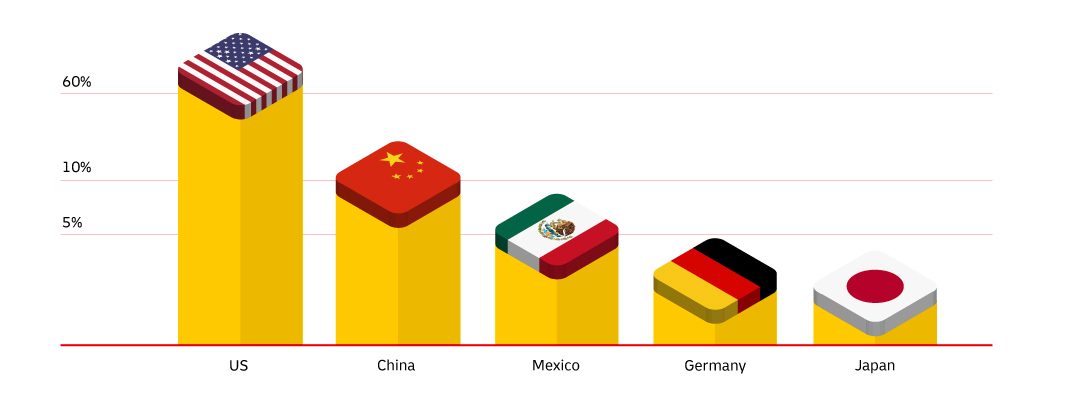
Shipping to Canada from the U.S. opens new opportunities to grow your business. As America's top trading partner, Canada imported nearly $350 billion worth of U.S. goods in 2024¹. Many U.S. businesses are already tapping into this demand, reaching Canadian consumers and building long-term loyalty. With the right shipping strategy, you can enter the Canadian market with confidence and deliver quickly and reliably.
Learn how to identify the biggest opportunities and prepare your business to ship to Canada and manage Canadian customs requirements.
ONLINE SHOPPING IN CANADA: MARKET OVERVIEW
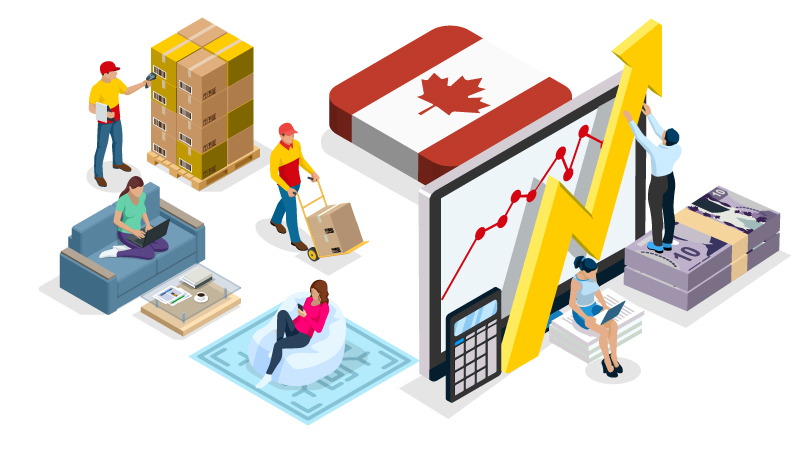
Canada embraces cross-border shopping
Canada has the highest cross-border purchase rate in North America, with 55.5% of online shoppers buying from foreign retailers in the past year.(2)

Informed buyers aplenty
Online shoppers in Canada are savvy: they research prices, compare across borders, and expect transparency on duties and taxes.
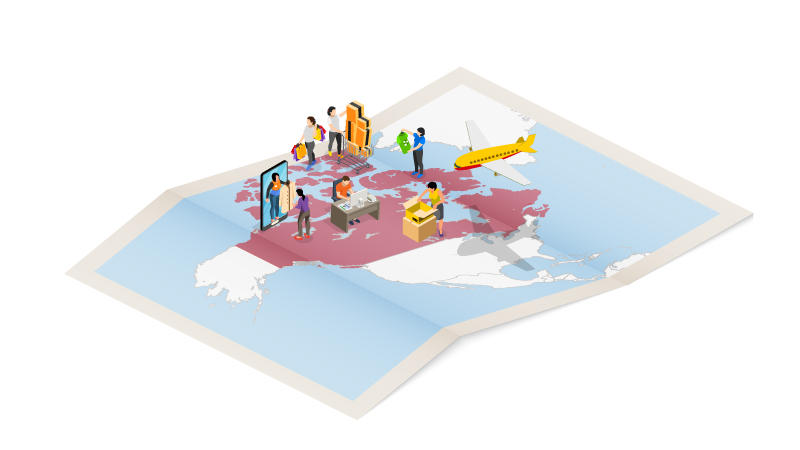
Mobile commerce drives growth
43% of cross-border purchases by Canadians are made through mobile devices, with projections indicating this will exceed 55% by 2025. (3)
Where do Canadians buy from?
A majority of Canadian imports into Canada come from the United States, followed by imports from China, Mexico and Germany. (4)
- US 66%
- China 19%
- Mexico 7%
- Germany 4%
- Japan 3%
SELLING TO CANADA: CONSUMER TRENDS YOU SHOULD KNOW
Where do Canadians shop online?
Top 5 B2C marketplaces (5)
1. Amazon.ca
2. Walmart.ca
3. Costco.ca
4. CanadianTire.ca
5. eBay.ca
What are Canadians buying online?
The leading product category for Canadian shoppers buying internationally is personal care and beauty. Consumer electronics, clothing, home goods, and accessories round out the top five.
● Apparel & footwear from European and Korean brands
● Skincare and beauty from Japan, South Korea, France
● Tech accessories & gadgets not available locally
● Specialty foods/snacks — especially from Asia, the UK, and Latin America
How are Canadians paying for their online purchases?
Canadian shoppers are accustomed to paying for their purchases in one of these ways. (6)
● Credit cards (Visa, Mastercard, Amex) still dominate
● PayPal is trusted for cross-border payment
● Buy Now, Pay Later (BNPL) services (Afterpay, Klarna) are trending with younger consumers
● Interac e-Transfer is mostly domestic, but popular
● WeChat & Alipay are slowly being adapted by brands
What matters to Canadian online shoppers?

Localized digital storefronts
Display prices in CAD, use Canadian English, and consider Canadian themes/promos around major holidays like Canadian Thanksgiving, Boxing Day.
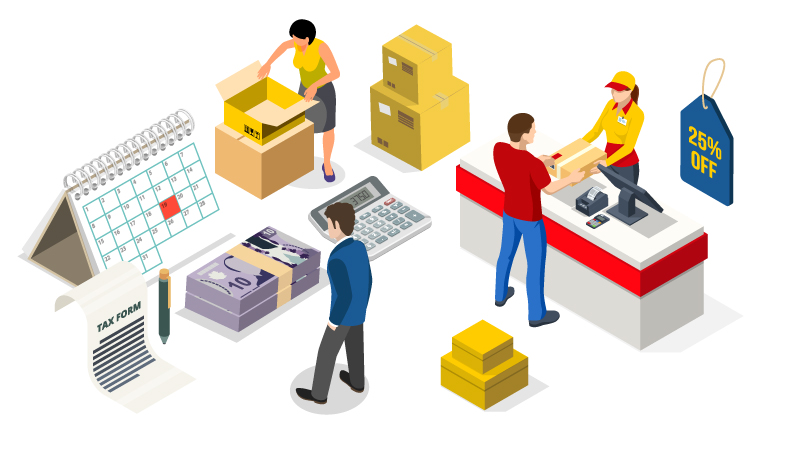
Transparent pricing
Avoid “border shock”: Canadians appreciate seeing all shipping and delivery costs upfront at checkout. Use Delivered Duty Paid (DDP) to ensure a smoother delivery experience.
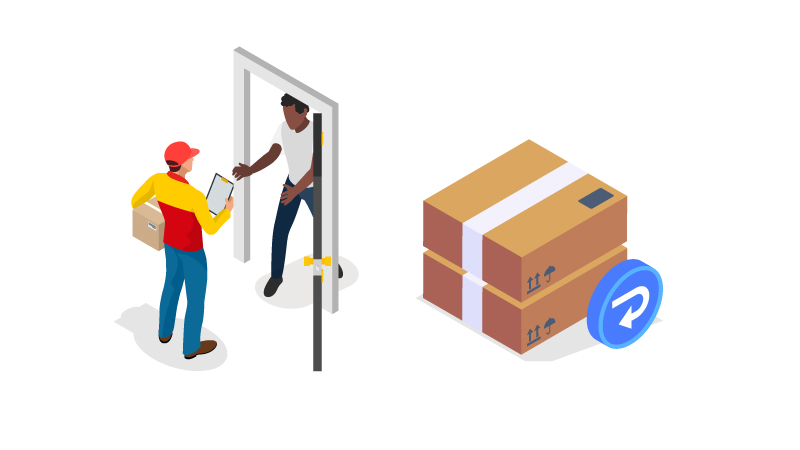
Offer easy returns
A clear, friendly return policy goes a long way – especially for apparel.
Top Canadian online shopping events
- Boxing Week (Dec 26 onward) is a major e-commerce surge — bigger than Black Friday for some Canadians.
- Family Day (February) and Victoria Day (May) often spark seasonal purchases.
- Back-to-school (late August) and Canada Day (July 1) are retail moments where patriotic and practical marketing both perform well.
- Singles Day and Black Friday (November 11 and late November): Many brands now include Singles Day in their promotional calendar.
HOW TO SHIP TO CANADA: CUSTOMS TIPS
Exporting to Canada, eh? Required documentation
When shipping north of the border, there are several pieces of documentation commonly required to clear goods through customs smoothly and help authorities determine what import taxes and duties are due:
● Commercial Invoice
● Waybill
● Certificate of Origin (if claiming preferential customs rates)
● Export and Import Licenses (check if your products require them)
This dedicated guide goes into detail on each document, including what information you’ll need to complete it.
Top trade challenges
Canadian shoppers expect transparency on duties and taxes on items purchased. One of the main friction points is unexpected fees at checkout/delivery, which can lead to cart abandonment or refused shipments.
● Duties and taxes at checkout: Not including them upfront is a major deterrent. Using Delivered Duty Paid (DDP) shipping is a smoother experience for Canadian consumers and reduces cart abandonment.
● Remote delivery surcharges: This can apply in vast rural areas and impacts delivery timelines and customer satisfaction.
Please note recent changes in tariffs may also impact shoppers’ decision to purchase.
Top exporting to Canada Tips from DHL Express
1. De Minimis Thresholds (Duties & and Taxes)
● Duties Threshold:
● Goods valued under CAD $150 are duty-free under most trade agreements. For the latest up-to-date information, check the Canada Border Services Agency (CBSA) website or talk to DHL Express.
● Taxes Threshold:
● Goods valued under CAD $40 are tax-exempt.
● Between CAD $40–$150, only taxes (GST/HST) are collected.
● Over CAD $150, both duties and taxes apply.
This makes low-value shipments (e.g., under $150 CAD) ideal for B2C cross-border brands.
2. Sales Tax (GST/HST)
● Canada applies federal and provincial sales tax at import.
● Goods and Services Tax (GST) (5%) is applied nationally.
● Some provinces (e.g., Ontario, BC, Quebec) charge HST or a combination of GST + PST, ranging from 5% to 15% total.
● See the breakdown of provincial HST rates.
● Tax is calculated on:
The CIF value = Cost of goods + Insurance + Freight.
3. Customs Duties
● Duty rates depend on the product category and country of origin.
● Apparel: often 16–18%
● Footwear: up to 20%
● Electronics: often duty-free
● Books: duty-free
Trade agreements like CUSMA (formerly NAFTA) allow duty-free access from the U.S. and Mexico if proper origin documentation is provided. Estimate duties and taxes HERE.
4. Tariff Codes & Classification Are Critical
● Misclassifying goods can cause overpayment, delays, or seizures.
● Use HS codes and consult your carrier or customs broker to ensure accurate product classification.
Learn more about HS codes.
5. Returns Can Be Taxed, Too
● If a customer returns an item, duties and taxes may not be refunded automatically.
● Merchants may need to apply for a duties/tax refund via CBSA, which can add friction to the process.
Tip: Offer local returns in Canada or set clear return policies that factor in potential tax or duty loss.
Prohibited and restricted commodities
Health, Beauty, and Wellness Products
● Products like skincare, cosmetics, supplements, vitamins, and essential oils must meet Health Canada regulations.
● Canada regulates ingredients, labeling, and health claims strictly to protect consumer safety.
● What to watch for:
● All cosmetics must follow the Cosmetic Regulations under the Food and Drugs Act.
● Natural health products (like herbal remedies or dietary supplements) require a Natural Product Number (NPN).
● Incomplete labeling or claims like “cures X” may result in your products being stopped at customs.
Tip: Stick to truthful, non-medical claims and double-check ingredient approval using Health Canada’s online database.
Textiles and Apparel
● Clothing and footwear generally flow easily into Canada, but labeling is crucial.
● Canada requires bilingual (English and French) fiber content and country of origin labeling.
Tip: Make sure your apparel labels meet Competition Bureau standards, especially for fiber content and origin claims like “Made in the USA.”
Electronics and Battery-Powered Goods
● All electronic products must meet Canadian safety and efficiency standards.
● To ensure devices are safe and energy efficient.
● Requirements:
● Most electronics require CSA, UL, or equivalent certification.
● Lithium batteries must meet Transport Canada’s dangerous goods requirements.
Tip: Only list electronics for sale in Canada if they’ve been certified or pre-approved for import.
If you're selling on marketplaces like Amazon.ca or through your own storefront, compliance is essential to avoid product delistings or delays.
Doing business in Canada: helpful trade resources
● Trade Commissioner Service (TCS) – Provides industry-specific guidance and Canadian market insights.
● Canada Border Services Agency (CBSA) – For tariff codes, valuation, and tax regulations.
● Canadian Digital Service (CDS) –Helpful for tech-forward businesses expanding cross-border and aiming to meet Canadian digital standards.
Thinking of exporting to Canada?
Join the thousands of the U.S. small businesses successfully selling their products to Canadian consumers with the help of DHL Express.
Start shipping to Canada and save1) https://ustr.gov/countries-regions/americas/canada#:~:text=Canada%20Trade%20Summary,(%245.0%20billion)%20from%202023
2) https://capitaloneshopping.com/research/cross-border-online-shopping-statistics/
3) https://www.statista.com/topics/7231/online-shopping-behavior-in-canada/#editorsPicks
4) https://globaledge.msu.edu/countries/canada/tradestats
5) https://www.yo-kart.com/blog/top-b2c-ecommerce-marketplace-in-canada
6) https://www.statista.com/forecasts/998521/biggest-e-commerce-payment-brands-in-canada

